Android应用加固的简单实现方案
个人博客
www.milovetingting.cn
Android应用加固的简单实现方案
概述
Android应用加固的诸多方案中,其中一种就是基于dex的加固,本文介绍基于dex的加固方案。
原理:在AndroidManifest中指定启动Application为壳Module的Application,生成APK后,将壳Module的AAR文件和加密后的APK中的dex文件合并,然后重新打包签名。安装应用运行后,通过壳Module的Application来解密dex文件,然后再加载dex。
存在的问题:解密过程,会还原出来未加密的原dex文件,通过一些手段,还是可以获得未加密的dex。
实现
APK和壳AAR的生成
新建工程,然后新建一个Module,作为壳Module,名字随意,这里命名为shell。
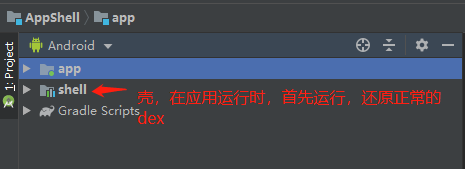
在壳Module中新建继承自Application的ShellApplication,重写attachBaseContext方法,在这个方法加载原来的dex
public class ShellApplication extends Application {
@Override
protected void attachBaseContext(Context base) {
super.attachBaseContext(base);
try {
//获取应用APK
File apkFile = new File(getApplicationInfo().sourceDir);
//解压目录
File apkUnzipDir = getDir("apk", Context.MODE_PRIVATE);
apkUnzipDir = new File(apkUnzipDir, "unzip");
//如果不存在,则解压
if (!apkUnzipDir.exists()) {
apkUnzipDir.mkdirs();
//解压
ZipUtils.unzipFile(apkFile, apkUnzipDir);
//过滤所有.dex文件
File[] files = apkUnzipDir.listFiles(new FilenameFilter() {
@Override
public boolean accept(File dir, String name) {
return name.endsWith(".dex");
}
});
//解密
File decryptDir = new File(apkUnzipDir, "decrypt");
decryptDir.mkdirs();
ArrayList<File> list = new ArrayList<>();
for (File file : files) {
if (file.getName().endsWith("classes.dex")) {
list.add(file);
} else {
File decryptFile = new File(decryptDir, file.getName());
EncryptUtils.decrypt(file.getAbsolutePath(), decryptFile.getAbsolutePath());
//添加到list中
list.add(decryptFile);
//删除加密的dex文件
file.delete();
}
}
//加载.dex文件
ClassLoaderUtil.loadDex(this, list);
} else {
ArrayList<File> list = new ArrayList<>();
list.add(new File(apkUnzipDir, "classes.dex"));
File decryptDir = new File(apkUnzipDir, "decrypt");
File[] files = decryptDir.listFiles();
for (File file : files) {
list.add(file);
}
//加载.dex文件
ClassLoaderUtil.loadDex(this, list);
}
} catch (Exception e) {
e.printStackTrace();
}
}
}
复制代码
修改app的AndroidManifest中application节点的name为壳Module的Application
<application
android:name="com.wangyz.shell.ShellApplication"
android:allowBackup="true"
android:icon="@mipmap/ic_launcher"
android:label="@string/app_name"
android:roundIcon="@mipmap/ic_launcher_round"
android:supportsRtl="true"
android:theme="@style/AppTheme">
<activity android:name=".MainActivity">
<intent-filter>
<action android:name="android.intent.action.MAIN" />
<category android:name="android.intent.category.LAUNCHER" />
</intent-filter>
</activity>
</application>
复制代码
在Gradle面板,双击app/Tasks/build/目录下的assembleRelease,生成未签名的APK
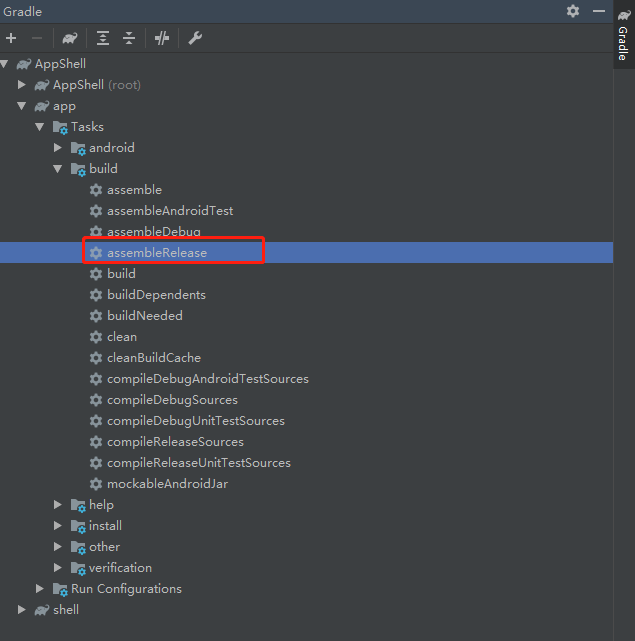
在app/build/outputs/apk/release/目录下,可以找到生成的apk:app-release-unsigned.apk
在Android Studio中,点击Build-Make Module 'shell',生成AAR。
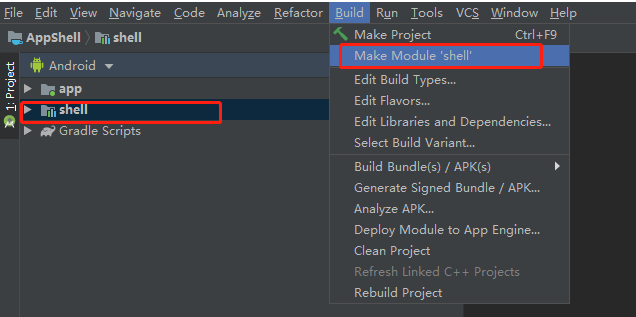
在shell/build/outputs/aar/目录下,可以找到生成的aar:shell-debug.aar
加壳的过程
加壳的实现流程如下:
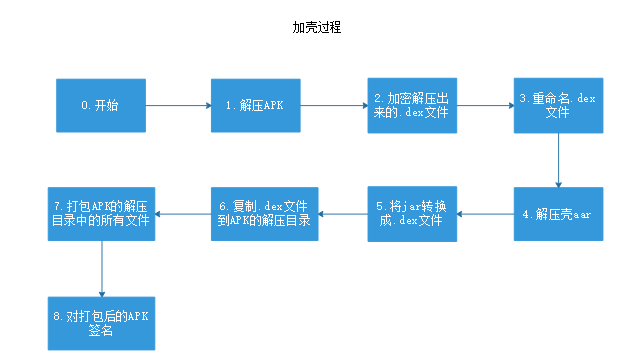
这里选择Eclipse新建Java工程来操作。
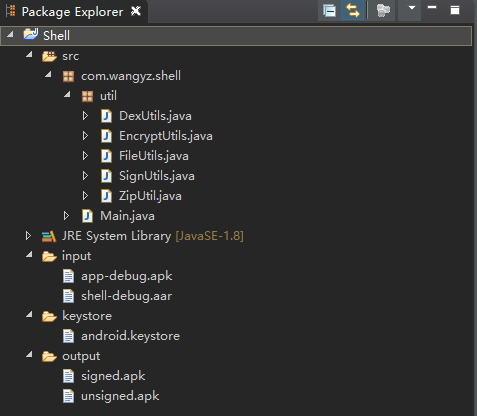
项目结构说明:
-
input:存放需要加壳的apk和aar
-
keystore:存放签名用到的keystore文件
-
output:打包后输出目录,signed为签名后的apk
需要配置的环境变量:
-
由于要用到dx来将jar转换成dex,因此需要配置dx的路径。在SDK/build-tools/下,有对应不同版本的build工具,这里选择28.0.0,进入28.0.0文件夹,可以看到dx.bat文件。在电脑的环境变量中,修改path,增加dx.bat路径:
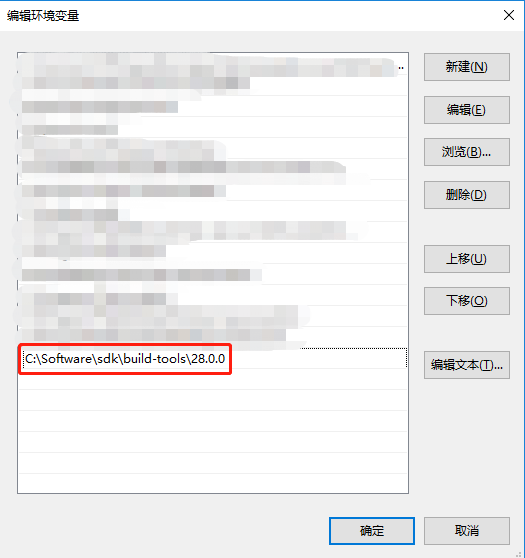
-
由于要用到jarsigner来签名apk,因此需要配置jarsigner的环境变量。一般Java开发的话,JDK配置好了后,这个就不需要再配置了。
配置好上面的环境变量后,关掉eclipse,然后重新启动eclipse
Main类中的代码逻辑:
try {
// APK
File apkFile = new File("input/app-debug.apk");
// 壳AAR
File shellFile = new File("input/shell-debug.aar");
// 判断文件是否存在
if (!apkFile.exists() || !shellFile.exists()) {
System.out.println("apkFile or shellFile missing");
return;
}
// *************解压APK*************
System.out.println("解压APK");
// 先删除输出文件夹下的所有文件
File outputDir = new File("output/");
if (outputDir.exists()) {
FileUtils.deleteAllInDir(outputDir);
}
// 创建apk的解压目录
File apkUnzipDir = new File("output/unzip/apk/");
if (!apkUnzipDir.exists()) {
apkUnzipDir.mkdirs();
}
// 解压APK
ZipUtil.unZip(apkFile, apkUnzipDir);
// 删除META-INF/CERT.RSA,META-INF/CERT.SF,META-INF/MANIFEST.MF
File certRSA = new File(apkUnzipDir, "/META-INF/CERT.RSA");
certRSA.delete();
File certSF = new File(apkUnzipDir, "/META-INF/CERT.SF");
certSF.delete();
File manifestMF = new File(apkUnzipDir, "/META-INF/MANIFEST.MF");
manifestMF.delete();
// 获取dex文件
File[] apkFiles = apkUnzipDir.listFiles(new FilenameFilter() {
@Override
public boolean accept(File file, String s) {
return s.endsWith(".dex");
}
});
for (int i = apkFiles.length - 1; i >= 0; i--) {
File file = apkFiles[i];
String name = file.getName();
System.out.println("dex:" + name);
String bakName = name.substring(0, name.indexOf(".dex")) + "_bak.dex";
System.out.println("备份dex:" + bakName);
bakName = file.getParent() + File.separator + name.substring(0, name.indexOf(".dex")) + "_bak.dex";
// 加密dex文件
EncryptUtils.encrypt(file.getAbsolutePath(), bakName);
System.out.println("加密dex:" + name);
// 删除原文件
file.delete();
}
// *************解压APK*************
// *************解压壳AAR*************
// 创建壳AAR的解压目录
System.out.println("解压壳AAR");
File shellUnzipDir = new File("output/unzip/shell/");
if (!shellUnzipDir.exists()) {
shellUnzipDir.mkdirs();
}
// 解压AAR
ZipUtil.unZip(shellFile, shellUnzipDir);
// 将jar转成dex
System.out.println("将jar转成dex");
File shellJar = new File(shellUnzipDir, "classes.jar");
File shellDex = new File(apkUnzipDir, "classes.dex");
DexUtils.dxCommand(shellJar, shellDex);
// 打包
System.out.println("打包APK");
File unsignedApk = new File("output/unsigned.apk");
ZipUtil.zip(apkUnzipDir, unsignedApk);
// 删除解压目录
FileUtils.delete("output/unzip/");
System.out.println("签名APK");
File signedApk = new File("output/signed.apk");
SignUtils.signature(unsignedApk, signedApk, "keystore/android.keystore");
System.out.println("Finished!!!");
// *************解压壳AAR*************
} catch (Exception e) {
e.printStackTrace();
}
复制代码
来看下具体的步骤:
解压APK
File apkUnzipDir = new File(root, "/output/unzip/apk/");
if (!apkUnzipDir.exists()) {
apkUnzipDir.mkdirs();
}
// 解压APK
ZipUtil.unZip(apkFile, apkUnzipDir);
复制代码
加密解压出来的dex文件、重命名dex文件
// 获取dex文件
File[] apkFiles = apkUnzipDir.listFiles((file, s) -> s.endsWith(".dex"));
for (int i = apkFiles.length - 1; i >= 0; i--) {
File file = apkFiles[i];
String name = file.getName();
System.out.println("dex:" + name);
String bakName = name.substring(0, name.indexOf(".dex")) + "_bak.dex";
System.out.println("备份dex:" + bakName);
bakName = file.getParent() + File.separator + name.substring(0, name.indexOf(".dex")) + "_bak.dex";
// 加密dex文件
EncryptUtils.encrypt(file.getAbsolutePath(), bakName);
System.out.println("加密dex:" + name);
// 删除原文件
file.delete();
}
复制代码
解压壳AAR
File shellUnzipDir = new File(root, "/output/unzip/shell/");
if (!shellUnzipDir.exists()) {
shellUnzipDir.mkdirs();
}
// 解压AAR
ZipUtil.unZip(shellFile, shellUnzipDir);
复制代码
将jar转成dex
File shellJar = new File(shellUnzipDir, "classes.jar"); File shellDex = new File(apkUnzipDir, "classes.dex"); DexUtils.dxCommand(shellJar, shellDex); 复制代码
打包
File unsignedApk = new File(root, "/output/unsigned.apk"); ZipUtil.zip(apkUnzipDir, unsignedApk); 复制代码
签名
FileUtils.delete(new File(root, "output/unzip/"));
System.out.println("签名APK");
File signedApk = new File(root, "output/signed.apk");
SignUtils.signature(unsignedApk, signedApk, keystore, keyStorePassword, keyPassword, alias);
System.out.println("Finished!!!");
复制代码
在output目录下,可以看到已经生成signed.apk。将apk安装在手机上,可以正常运行,达到加固的目的。
源码
源码地址: github.com/milovetingt…
基于gradle的自动加固
上面的加固方式,需要在生成APK后,再生成壳Module的AAR文件,然后再通过工具来生成加固的APK。这个过程,手动操作还是比较麻烦的。可以借助gradle来生成插件,在生成APK后,自动完成加固。
插件生成
新建工程Plugins,新建module,名为shell,作为加壳的插件。
清空shell模块下的build文件内容修改如下:
apply plugin: 'groovy'
dependencies {
implementation gradleApi()
implementation localGroovy()
}
复制代码
删除shell模块下的src/main/目录下的所有文件,然后新建目录groovy,在groovy中再新建包:com/wangyz/plugins,具体可以根据实际情况修改。
新建ShellConfig.java,作为自定义配置的bean
public class ShellConfig {
/**
* 壳Module名称
*/
String shellModuleName;
/**
* keystore的位置
*/
String keyStore;
/**
* keystore的密码
*/
String keyStorePassword;
/**
* key的密码
*/
String keyPassword;
/**
* 别名
*/
String alias;
}
复制代码
新建ShellPlugin.groovy,主要的逻辑都在这里面
package com.wangyz.plugins
import com.wangyz.plugins.util.ShellUtil
import org.gradle.api.Plugin
import org.gradle.api.Project
class ShellPlugin implements Plugin<Project> {
def printLog(Object msg) {
println("******************************")
println(msg)
println("******************************/n")
}
def createDir(Project project) {
File shellDir = new File("${project.rootDir}/ShellAPK")
if (!shellDir.exists()) {
printLog("create dir")
shellDir.mkdirs()
}
}
def deleteDir(Project project) {
File shellDir = new File("${project.rootDir}/ShellAPK")
if (shellDir.exists()) {
printLog("delete dir")
shellDir.deleteDir()
}
}
@Override
void apply(Project project) {
printLog('ShellPlugin apply')
project.extensions.create("shellConfig", ShellConfig)
project.afterEvaluate {
project.tasks.matching {
it.name == 'assembleRelease'
}.each {
task ->
printLog(task.name)
def shellProject = project.parent.findProject("${project.shellConfig.shellModuleName}")
printLog("shellProject:$shellProject")
File shellDir = new File("${project.rootDir}/ShellAPK")
File apkFile
File aarFile = new File("${shellProject.buildDir}/outputs/aar/shell-release.aar")
project.android.applicationVariants.all {
variant ->
variant.outputs.each {
output ->
def outputFile = output.outputFile
printLog("outputFile:${outputFile.getAbsolutePath()}")
if (outputFile.name.contains("release")) {
apkFile = outputFile
}
}
}
task.doFirst {
//删除原来的文件夹
deleteDir(project)
//生成文件夹
createDir(project)
//生成aar
printLog("begin generate aar")
project.exec {
workingDir("../${project.shellConfig.shellModuleName}/")
commandLine('cmd', '/c', 'gradle', 'assembleRelease')
}
printLog("generate aar complete")
//复制文件
printLog("begin copy aar")
project.copy {
from aarFile
into shellDir
}
printLog("copy aar complete")
}
task.doLast {
printLog("begin copy apk")
//复制文件
project.copy {
from apkFile
into shellDir
}
printLog("copy ${apkFile.name} complete")
printLog("begin shell")
ShellUtil.shell(apkFile.getAbsolutePath(), aarFile.getAbsolutePath(), shellDir.getAbsolutePath(), project.shellConfig.keyStore, project.shellConfig.keyStorePassword, project.shellConfig.keyPassword, project.shellConfig.alias)
printLog("end shell")
}
}
}
}
}
复制代码
ShellPlugin类实现Plugin接口,实现apply方法,当插件被apply时,就会回调这个方法。
首先创建配置,这样引用插件的gradle文件就可以定义shellConfig节点,插件就可以拿到配置节点里的内容
project.extensions.create("shellConfig", ShellConfig)
复制代码
指定在assembleRelease后执行我们自己的逻辑
project.afterEvaluate {
project.tasks.matching {
it.name == 'assembleRelease'
}.each {
task ->
printLog(task.name)
}
}
复制代码
具体的逻辑定义在task的闭包中,在生成apk前,执行task.doFirst里的逻辑,首先生成aar,然后执行生成apk的逻辑,然后在task.doLast中执行加壳的操作。
printLog(task.name)
def shellProject = project.parent.findProject("${project.shellConfig.shellModuleName}")
printLog("shellProject:$shellProject")
File shellDir = new File("${project.rootDir}/ShellAPK")
File apkFile
File aarFile = new File("${shellProject.buildDir}/outputs/aar/shell-release.aar")
project.android.applicationVariants.all {
variant ->
variant.outputs.each {
output ->
def outputFile = output.outputFile
printLog("outputFile:${outputFile.getAbsolutePath()}")
if (outputFile.name.contains("release")) {
apkFile = outputFile
}
}
}
task.doFirst {
//删除原来的文件夹
deleteDir(project)
//生成文件夹
createDir(project)
//生成aar
printLog("begin generate aar")
project.exec {
workingDir("../${project.shellConfig.shellModuleName}/")
commandLine('cmd', '/c', 'gradle', 'assembleRelease')
}
printLog("generate aar complete")
//复制文件
printLog("begin copy aar")
project.copy {
from aarFile
into shellDir
}
printLog("copy aar complete")
}
task.doLast {
printLog("begin copy apk")
//复制文件
project.copy {
from apkFile
into shellDir
}
printLog("copy ${apkFile.name} complete")
printLog("begin shell")
ShellUtil.shell(apkFile.getAbsolutePath(), aarFile.getAbsolutePath(), shellDir.getAbsolutePath(), project.shellConfig.keyStore, project.shellConfig.keyStorePassword, project.shellConfig.keyPassword, project.shellConfig.alias)
printLog("end shell")
}
复制代码
在src/main/目录下新建目录:resources/META-INF/gradle-plugins,再创建com.wangyz.plugins.ShellPlugin.properties的文件,这里的文件名就是后面插件被引用时的名字,com.wangyz.plugins.ShellPlugin.properties内容如下:
implementation-class=com.wangyz.plugins.ShellPlugin 复制代码
key为implementation-class,这个是固定的
value为com.wangyz.plugins.ShellPlugin,就是上面在groovy里创建的类
到这里,定义好了插件,还需要发布到仓库。在shell模块的build.gradle文件中增加以下配置
apply plugin: 'maven-publish'
publishing {
publications {
mavenJava(MavenPublication) {
groupId 'com.wangyz.plugins'
artifactId 'ShellPlugin'
version '1.0.0'
from components.java
}
}
}
publishing {
repositories {
maven {
url uri('E://Repository')
}
}
}
复制代码
sync项目后,可以在Gradle面板看到新生成的task
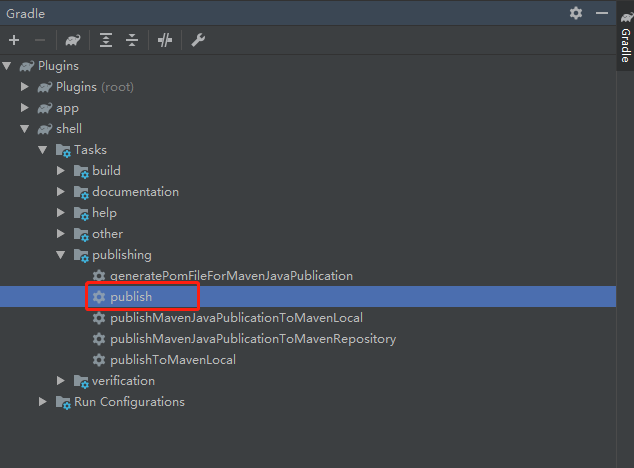
双击publish,会将插件发布到我们指定的仓库
11:22:39: Executing task 'publish'... Executing tasks: [publish] in project D:/Project/Plugins/shell Parallel execution with configuration on demand is an incubating feature. :shell:generatePomFileForMavenJavaPublication :shell:compileJava NO-SOURCE :shell:compileGroovy UP-TO-DATE :shell:processResources UP-TO-DATE :shell:classes UP-TO-DATE :shell:jar UP-TO-DATE Could not find metadata com.wangyz.plugins:ShellPlugin/maven-metadata.xml in remote (file:/E:/Repository) :shell:publishMavenJavaPublicationToMavenRepository :shell:publish BUILD SUCCESSFUL in 0s 5 actionable tasks: 2 executed, 3 up-to-date 11:22:40: Task execution finished 'publish'. 复制代码

插件应用
在需要加壳的工程的根build.gradle中引入插件:
buildscript {
repositories {
maven {
url uri('E://Repository')
}
}
dependencies {
classpath 'com.wangyz.plugins:ShellPlugin:1.0.0'
}
}
allprojects {
repositories {
maven {
url uri('E://Repository')
}
}
}
复制代码
在app的build.gradle中应用插件:
//引入插件
apply plugin: 'com.wangyz.plugins.ShellPlugin'
//配置插件
shellConfig {
shellModuleName = 'shell'
keyStore = 'E://Code//Android//android.keystore'
keyStorePassword = 'android'
keyPassword = 'android'
alias = 'android'
}
复制代码
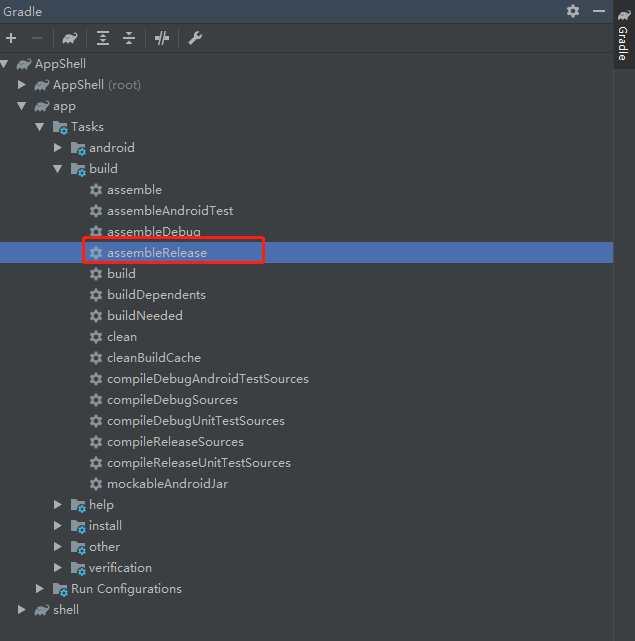
由于插件中会用到gradle命令,因此需要先配置gradle的路径到环境变量path中。具体配置,可以找下相关资料,这里不再展开。
双击执行assembleRelease命令,就会在根目录/ShellApk/output/下生成加壳签名后的apk。
安装加壳签名后的apk,可以正常运行。
- 本文标签: ORM https category IDE root list 博客 pom id HBase App 源码 build bean git 加密 UI zip value 删除 maven MQ cat 代码 classpath 开发 Action ip ArrayList 配置 java key http remote IO find GitHub ssl dependencies ACE shell Lua 安装 目录 XML ask cmd plugin API 备份 插件 Word eclipse bug map Android tab src
- 版权声明: 本文为互联网转载文章,出处已在文章中说明(部分除外)。如果侵权,请联系本站长删除,谢谢。
- 本文海报: 生成海报一 生成海报二










![[HBLOG]公众号](https://www.liuhaihua.cn/img/qrcode_gzh.jpg)

